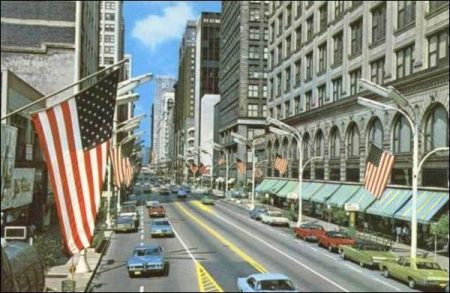Through the gateway at Shawneetown, down the main highway of the Ohio River, settlers converged upon the young State from many directions–from North Carolina, Tennessee, Virginia, Kentucky, Maryland, Pennsylvania, New York, and the New England States. In flatboats and keelboats loaded with horses, cattle, and furniture, they came. Some, too poor to pay for this kind of transportation, struck out across country and braved the wilderness.
“The eye sometimes surveys the green prairie without discovering on the illimitable plain a tree or bush, or any other object, save the wilderness of flowers and grass,” wrote an English traveler who crossed the State in the twenties. “On other occasions the view is enlivened by groves dispersed like islands on the plain, or by a solitary tree rising above the wilderness.”
Because of a widespread belief in the superior fertility of woodland, because of the toughness of the prairie sod and the pioneer’s constant need for timber, the first settlers built their cabins along the river bottoms and in the groves. But as population increased and desirable sites became scarce, hardy adventurers pushed out into the prairies, and thus discovered the almost limitless richness of the great treeless regions.
Despite hardships, they kept coming, first the advance guard of lone-wolf trappers and hunters, then the poor squatters, followed by farmers with stock and capital, and finally young men of education seeking their fortunes in land and trade. Socialistic and religious colonies organized elsewhere and migrated here: Birkbeck’s English colony at Albion ( 1818), the Quakers on the Fox River ( 1835), Swiss wine-grape growers along the Ohio, Bishop Chase and his jubilee College at Robin’s Nest ( 1839), later the Swedish Janssonists at Bishop Hill ( 1846), and the Mormons ( 1839) and Icarians ( 1850) at Nauvoo.
In Illinois As It Is, Fred Gerhard wrote in a chapter entitled “Hints To Immigrants”: “A pair of good horses, a wagon, a cow, a couple of pigs, several domestic fowl, two ploughs (one for breaking the prairie, and the other for tillage), together with a few other tools and implements, are all that is necessary for a beginning. A log house can soon be erected.”
The frontier towns were busy centers of trade; the produce of the land and the forest–furs, skins, honey, corn, whiskey, venison, beef, pork–could be bartered for goods and shipped down to New Orleans in flatboats. In these towns all elements rubbed elbows, “the young college graduate and the lone-wolf trapper, the fine lady and the squatter’s wife.”
But the great curse of the expanding frontier fell on these towns and farms: they lacked capital. The produce of the West poured down the Mississippi–only to accumulate on the wharves at New Orleans. The small sums of money that dribbled through to the West went directly back East to pay debts. The Federal banking system, inadequate in its credit mechanisms, and the State banks, unstable and uncontrolled, made merchants and farmers distrustful of all banking systems.
The State banks at Edwardsville and Shawneetown failed in the early twenties, but in the late thirties a much more serious confusion occurred, in both Federal and State banking systems. Soon all bank notes were so suspect that barter of tangibles was quite commonly preferred to any kind of paper money. But there was only a small market for produce, and debt-ridden farmers, unable to dispose of their goods and too numerous to be dispossessed, filled the State.
Not far behind the first settlers came the frontier church. A Methodist circuit-rider, the Reverend Joseph Lillard, stopped at New Design in 1793. The first Baptist church was founded there three years later; the denomination was strengthened by the coming of John Mason Peck and his establishment, the Rock Spring Seminary, in 1827. The Methodists, with their circuit-riding preachers, began to arrive in 1801; they taught simplicity in dress and living, and sowed the beginnings of the anti-slavery movement in the State. In 1796 came the Presbyterians with the Reverend John Evans at their head; insisting on a learned clergy, they quickly established their denominational colleges. Despite its early missionary work and the adherence of the French settlers, the Catholic church grew more slowly; not until 1844 was the separate diocese of Chicago established.
The question of public education was debated bitterly. The largest part of the population had been drawn from the South, which had developed no public school systems. Those from the North thought that education was a function of the church. Finally, in 1825, a law allowing localities to levy school taxes was passed, only to be repealed soon afterwards; it was not until 1845, as the result of a campaign waged by the workers and farmers of the State, that a free education law was again passed, and even then years elapsed before many communities took advantage of it.
The population of the State grew from 55,211 in 1820 to 157,445 in 1830. With this growth came a tremendous shift in the distribution of population. Opened in 1825, the Erie Canal brought swarms of immigrants by way of the Great Lakes, repeating the process of settlement that had been occurring through the Ohio River Valley for half a century. Fort Dearborn, rebuilt in 1816, was the nucleus of a settlement incorporated as the town of Chicago in 1833, and as a city in 1837.
A feverish campaign for internal improvements spread in the thirties; by the end of the decade the movement had brought the State to the verge of bankruptcy under a staggering debt of $14,000,000. In 1837 a flood of measures had been passed by the legislature, providing for the building of railroads, canals, and turnpikes, and the improvement of rivers and harbors. A canal charter had been granted in 1825; in 1827 Congress had given 224,322 acres to the State. The Illinois and Michigan Canal was begun in 1836. The Wabash, Illinois, Kaskaskia and Rock Rivers were to be deepened and improved. A great Illinois Central Railroad from the western terminus of the canal at La Salle to the mouth of the Ohio River at Cairo was proposed, with two east-west lines, “the Southern Cross” from Alton to Mount Carmel, and “the Northern Cross” through Springfield and Quincy.
At the same time the question of removing the State capital from Vandalia arose; Alton, Jacksonville, Peoria, Springfield, and others, wished to succeed it. They also wanted the benefits of the internal improvements. Consequently, in the session of 1837, the Sangamon County delegates, called the “Long Nine,” because all its members-including Abraham Lincoln–were exceptionally tall men, arranged a trade. They voted internal improvements for these towns in return for votes for Springfield as the capital.
The hysteria of the internal improvement scheme was broken by the panic of 1837. For the enormous debt with which the State was burdened, it was able to show only one short railroad line, the Northern Cross from Springfield to Meredosia; built at a cost of $1,850,000, the road was sold at auction some years later for $21,000. The Illinois and Michigan Canal, begun in 1836, was not completed until 1848.
A tragic episode in the history of the State, the Black Hawk War of 1832, saw the passing of the Indian from Illinois forever. The Sauk and Fox once claimed all the land west of the Fox and the Illinois, and east of the Mississippi Rivers. In 1804, while five of their chiefs were in St. Louis arranging for the release of one of their tribesmen charged with murder, they were plied with drink. In return for an annuity of a thousand dollars a year, and the right to live and hunt in the area so long as it belonged to the Federal government, they deeded the land away.
In 1816, 1822, and 1825, the agreement was renewed, although how well the Indian chiefs understood the terms of these treaties will always remain a mystery. The tribes continued to live at their great villages, the Sauk on the north side of Rock River near the present city of Rock Island, and the Fox three miles away on the Mississippi. Miners heading for the newly discovered lead mines at Galena saw their fertile lands, and by 1825 white settlers began to move in upon them. Realizing the inevitability of a conflict, Keokuk, the peace-time chief of the tribes, decided to move Pcross the Mississippi into what is now Iowa.
But Black Hawk, a war chief less friendly to the settlers, persuaded by British and Indian friends that one thousand dollars a year was manifestly inadequate payment for this vast region, decided to remain on the land. The majority of the tribe left for Iowa, but friction soon developed between those who remained and the settlers; Black Hawk ordered the whites to stop plowing up the burial grounds of his ancestors and planting in the cornfields of the tribes. Governor Reynolds proclaimed Illinois in a “state of actual invasion” by the Indians and called for volunteers. When the volunteer army approached the Indian village on June 25, 1831, Black Hawk ordered the village abandoned, and under cover of night the Indians moved across the Mississippi into Iowa without a struggle.
In the spring of 1832, Black Hawk and four hundred braves, together with their women and children, crossed the Mississippi, apparently intending to go to the Winnebago in Wisconsin, and raise a corn crop with them. Their mission was misunderstood, and troops again took the field. Under Major Isaiah Stillman, they came upon the Indians encamped. Black Hawk sent three braves with white flags to explain that no hostilities were intended. In the excitement accompanying the negotiations, shooting began; three Indian tribesmen, including one of the truce-bearers, were killed. In the ensuing Battle of Stillman’s Run, the white men were ingloriously routed.
Guerrilla warfare began, with the Indians proving elusive in the forests. In July, his forces weakened by hunger, Black Hawk decided to surrender. He wanted to return his people to Iowa, but again his offer of truce went unheeded. Most of the warriors were killed at the Battle of Bad Axe, August 2, 1832, where the white men turned savage and committed indescribable acts of cruelty, even scalping the Indians. As women and children of the tribes tried to cross the Mississippi on rafts, a gunboat opened fire, killing or drowning most of them. Those who escaped the Battle of Bad Axe and managed to cross to the west side of the river were set upon by the Sioux, the traditional enemies of the Sauk and Fox. These events, together with the great peace pow-wow held in Chicago in 1833, in which the Potawatomi and their allies ceded all their land in Illinois and moved west of the Mississippi, removed the last of the Indians from the State.
A decade later came the Mormon wars. Driven from Missouri, the Mormons moved across the Mississippi to the town of Nauvoo in 1839. They received many concessions from the State legislature, and built a community that exceeded Chicago and Galena in population and industry. Then dissension developed; men who were excommunicated, turned on the colony with exposés, charging that the interests in the community of Joseph Smith, the leader, were financial and political rather than spiritual. Trouble with neighbors grew. In 1844 warrants were issued against Joseph Smith and his brother Hyrum for rioting and treason.
They were arrested and incarcerated in the jail at Carthage. While the prisoners were awaiting trial, the jail was broken into by a mob on June 27, and the Smith brothers were murdered. Then began the acts of violence which, for two years, amounted almost to civil war, with Governor Ford marching and countermarching the militia across the State in an effort to preserve peace. The problem was finally solved after it had flared into open battle; the Mormons, yielding to superior force, left the State and migrated to Utah.
A new constitution was adopted in 1848. The population of the State increased from 157,445 in 1830 to 851,470 in 1850. The constitution of 1818 was obviously inadequate, and many reforms were needed. The new constitution provided for popular election of all State officials and popular referendum on questions of policy. As a compromise between the township system brought from the North, and that of counties from the South, the new constitution provided for both forms of local organization.
Views: 171



